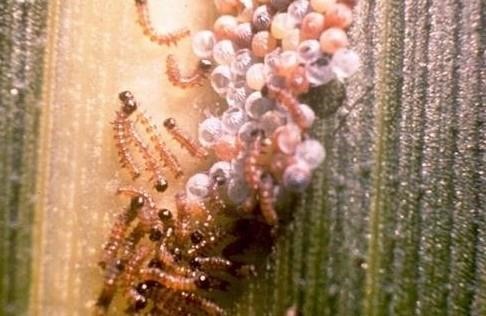By John Tooker
Western bean cutworm is active in Pennsylvania corn fields so it would be wise to scout fields for eggs and young caterpillars to understand the threat that this pest species poses to your fields. For about six years, Penn State Extension and the Department of Entomology trapped for western bean cutworm to try to understand the population dynamics of this species, which we first found in Pennsylvania in 2009. Even though we captured moths each year, we discontinued this effort in 2016 because we rarely found caterpillars in nearby corn fields; the numbers of moths in traps did not appear very informative. We have been fortunate in Pennsylvania because populations of this pest of corn and dry and snap beans have been mild, but western bean cutworm has been more serious in New York, Michigan, Ohio, Wisconsin, and Ontario, where it has caused economic damage.
This year at our research farm in Centre County we are finding egg masses on upper leaves of corn (Figure 1), suggesting that this pest species is somewhat more common than in previous years. Unlike many "cutworm" species, this caterpillar species is active mid-season and prefers to feed upon reproductive stage corn, particularly on the tassel and developing ear. I encourage folks to be on the lookout for eggs and caterpillars of this species in their corn fields. You should also be aware that corn hybrids with the Herculex 1 trait (i.e., the Cry1F protein) can help suppress populations of this caterpillar, but often do not provide adequate levels of protection. No other Bt traits provide protection against western bean caterpillars. A generally accepted economic threshold for western bean cutworm is 5% of plants having eggs or larvae, so corn and silage fields above this level would benefit from an insecticide application. Of course, the timing of this application is key because it needs to occur after eggs hatch but before caterpillars enter ears and are protected from insecticides by husks. Fields that do not have populations that exceed the economic threshold are unlikely to benefit from insecticides and may actually suffer if the insecticide flares aphid populations, which grow in the absence of natural enemies. Young western bean cutworm caterpillars have black heads and yellow, spiny-looking bodies (Figure 2). Later in the season, more mature western bean caterpillars look similar to corn earworm but do not have lines down the sides of its body like corn earworm does and has three distinct light-brown lines on its "neck" just behind its head (Figure 3).

Figure 2. Newly hatch western bean cutworm caterpillars. Note the black heads and spiny-looking body (Photo by Frank Peairs, Colorado State University, Bugwood.org)

Figure 3. Western bean cutworm caterpillar with the distinct brown lines on its "neck." (Photo by Eric Bohnenblust, Penn State Department of Entomology)
Source : psu.edu